Creating a Project Budget – A Complete Guide
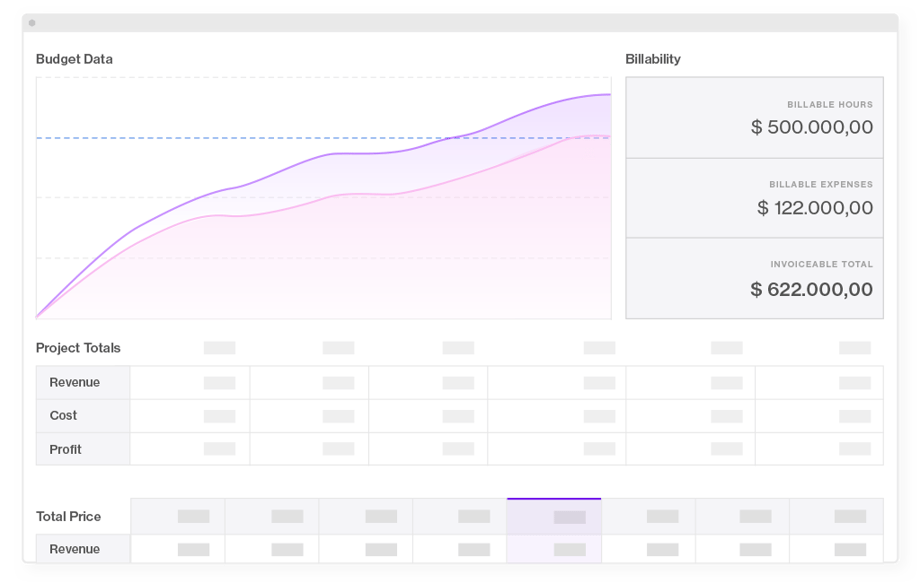
A project without a budget is like a car without fuel. Funding is essential to get the project started and set all resources in motion. If you work in a project-based company as a manager, creating a project budget and helping those wheels spin will most likely be your full responsibility.
At first glance, the whole budget thing might seem intimidating, but eventually, you’ll realize that all you need is to iron out the plan. This guide is for everyone who'd like to discover what goes into making a project budget, and how to calculate one (with or without professional tools). If you're on the go, you can download the full eBook here.
- What is project budgeting?
- Why a project budget is important
- Typical project cost categories
- Approaches to estimating a project budget
- How to create a basic project budget in five easy steps
- Automating project budget creation
- Learn from the experts: The best budgeting practices
- A checklist of things to create a project budget
- How project management systems can help
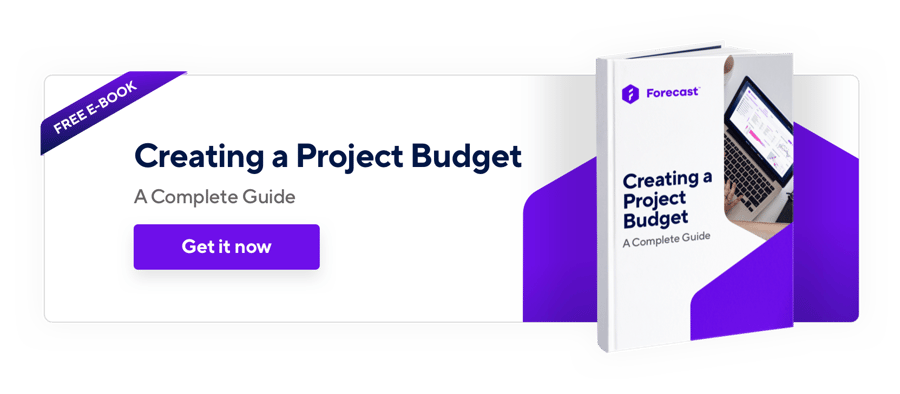
What is project budgeting?
Before we jump to the ins and outs of creating a project budget, let’s define what a project budget is in the first place.
The budget for a project is the combined costs of all activities, tasks, and milestones that the project must fulfill. In short: it’s the total amount of money you’ll need to finish the project that should be approved by all the stakeholders involved.
You start creating a project budget during the kickoff phase of the project and continue monitoring it till the project reaches the finish line. A meticulously planned project budget is the holy grail of the new service economy where scaling smoothly and sustainably is critical to company survival.
Why a project budget is important
There are at least three reasons to explain the importance of having a project budget plan.
First, it’s an essential part of securing project funding. The numbers will tell stakeholders exactly how much money is needed to button up the project and when the money is needed.
Second, a well-planned budget provides the basis for project cost control. Having an end budget estimate helps you measure the project’s actual cost against the approved budget and see how much costs you’ve burned already. It will give you an understanding of how the project is progressing and if any changes need to be made to the plan.
Third, a project budget has a direct effect on the company's financial viability. When calculated feasibly and with resource constraints in mind, a project budget will increase the operating margin and improve overall project success.
Now that the purpose of a budget is clear, let’s switch to the mechanics.
Typical project cost categories
Planning project costs is an essential step in mapping out a project budget. To do so, you’ll need to create a list of timely line items that are relevant for the project. Here’s a table with common project cost categories to help you get started:
|
|
|
|
Human resources |
Salary rates of full-time and temporary workers |
|
Travelling spendings |
Anyone who travels from one location to another to do project work (including budget for meals and lodging) |
|
Training fees |
Conferences, workshops, outside contractors |
|
Material resources |
All the items your team might need to perform the work, including software, equipment, or other unique materials |
|
Research expenses |
Studies or data to support your project and deliver the best value |
|
Professional services |
Legal advice, consultants, market research firms, etc. |
|
Capital expenditures |
Equipment or technical upgrades to complete the project |
|
Contingency reserves |
Contingency funds to allow for flexibility and reduce risks of budget overruns, usually 5-10% of the budget |
Some of the costs, such as training costs to teach users to use a product or maintenance costs, are often overlooked by managers, so it’s important to think ahead if there are costs related to the project that will come up once it’s complete.
Approaches to estimating a project budget
We all know that it can be extremely challenging to estimate the size and cost of a project, since a project by definition is unique in nature, often a new product, service or business change. The greater the size and complexity of the project, the harder it can be to do this properly. Here are five techniques that can greatly improve the project estimation process and accuracy:
Bottom-up estimation
Rate the individual parts of the project plan and tot them up
Bottom-up estimation is one of the best and foolproof ways to prepare a project budget. It anticipates estimating individual parts of the project, such as tasks, milestones, or phases, and totaling them to get project cost. This method can be applied if you’re at the point of creating a statement of work. If you’re sure you know every grain of the project, bottom-up estimating is the way to go.
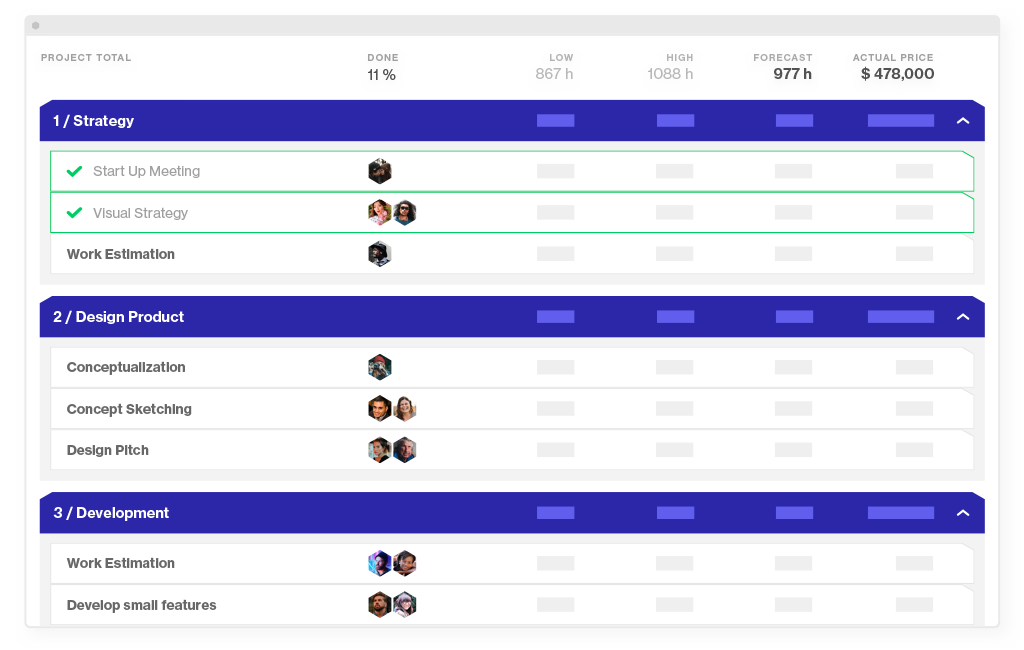
Forecast has got a complete suite of tools for bottom-up estimating and planning. Better than any template, the Scoping page offers functionalities to break down the project by milestones and tasks. Fill in the rate cards for each role, and get the platform to calculate project cost for you automatically.
The downside of the bottom-up approach is that it takes plenty of time to go down to the smallest detail of the project. Additionally, our in-house research has shown that 71% of tasks are created after the project’s start date. In reality, project requirements change even before the ink is dry on your statement of work. Also, because it’s very granular, at some point you might suffer from inflation affecting the cost of your estimates.
Since project estimation is a process, the estimate will always undergo several iterations of refinement throughout the project’s lifespan. The estimation accuracy will thus improve as the project scope is more thoroughly understood. This also means that the uncertainty will lessen the further the project progresses towards completion.
Top-down estimation
Figure out the total, and then split it into tasks or milestones
Top-down estimation is opposite to the bottom-up approach mentioned above and a completely different ball game. It starts with the project budget total and involves breaking it down into smaller chunks. Top-down estimation is typically used when you have a fixed price project with the budget set in stone.
The main disadvantage of this approach is loose estimations at the project initiation phase. It is difficult to accurately predict the budget before you understand the scope of work and have a project plan. This process might turn very challenging, especially when you can’t measure the accuracy of the initial quote against final project delivery.
Top-down approach can cause misalignment between the selling and the project teams. Consider the following scenario:
The Account Manager sells a Honda, the Project Manager scopes out a Ferrari. The problem isn’t that the AM is bad at selling, or the PM bad at scoping projects, it’s that in way too many companies the right hand doesn’t know what the left is doing. The PM only sees a lump sum assigned to the project budget, without enough context as to why it’s set that way.
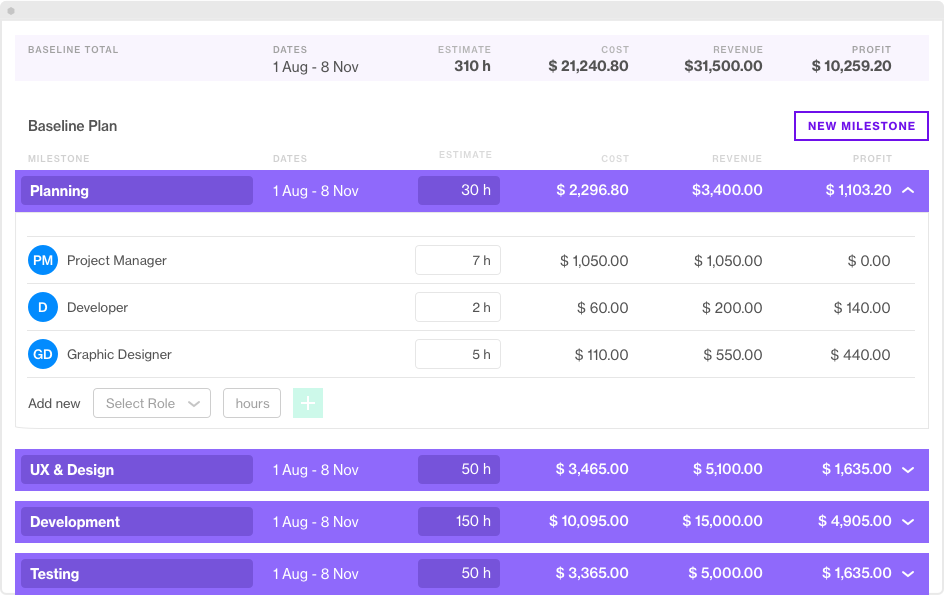
The key to success with top-down estimation is having a clear understanding of how each task in the scope affects the initially set fixed price, which takes forever to calculate manually. Forecast, however, makes it very easy. Besides being a huge help in bottom-up estimations, the platform’s Baseline caters for top-down planning. You can see early on when there’s just no way to line up the price with the expectations.
Through Baseline in Forecast, you can see the prices set for each stage of the project, and use that to quickly create a rough project scope that can be profitable at that price and still fulfill the customer’s vision. Learn more here:
Analogous estimation
Analyze the data in similar projects to decide the cost
If you’re not totally new to project management, you’ve probably managed a few projects before and can tell what works and what doesn’t. Using analogous estimation, you would rely on the budget data and best practices from your previous projects to form an opinion about how much the current one could cost the client.
Analogous estimation can sometimes be a back-and-forth task, but why not do it the smart way by using project management software? In Forecast, you can easily duplicate one of the past projects to create another one with the same tasks. Then in an instant, you can adjust it to make a better, more situational estimate. Another way to use analogous estimation is to rely on Auto Schedule that has an algorithm which learns from past projects and can be applied to estimate tasks, predict the delivery date, and determine the project budget.
There are always similarities between projects, but it doesn’t mean that you should make decisions based solely on them. Every project is unique. In case you haven’t managed projects before, you can often find usable examples with a quick search.
It goes without saying that analogous estimation is not as accurate as other techniques like bottom-up estimation. But the advantage of analogous estimating is that it’s super quick and is especially useful when there’s limited information about the project.
Parametric estimation
Using data and project variables to suggest the total
In contrast to analogous estimation, parametric approach is more accurate. It takes cost variables or data points from specific parts of specific projects and applies them to the current project, so you make more decisions based on data.
The advantage of this process is that it’s more accurate than the analogous estimation because it employs more than one data set and uses the statistical relationship between historical data and variables.
The disadvantage is that with digital projects it’s often hard to find useful data points.
Three-point estimation
Take the best, worst, and most likely case estimates to do the average
Three-point estimation is one of the most sensible and pragmatic techniques as it takes into account a weighted average based on the best, worst, and most likely case budget scenarios and encourages you to think from multiple perspectives. Thus you can figure out a realistic cost estimation.
The upside of the three-point estimation technique is that you can reduce the risk of going over budget, as it will be indicated in your plan, and eventually deliver on expectations.
There are no substantial disadvantages of three-point estimation. Sometimes it takes longer to create a budget using this approach, but at the end of the day, it’s worth the effort spent.
Check out these Project Estimation Techniques 101 for a more detailed perspective.
How to create a basic project budget in five easy steps
You can use project budgeting methods above, or stick to a simple project budget planning routine. Essentially, these five steps can help you put the finances together and create a project budget summary:
- Break down your project into tasks and milestones. Working with your task list will give you an understanding of what you’ll need to accomplish and help you with project cost management. If you already have a task list, that’s fine, and you can start right off. But if you don’t, start creating a scope and writing down everything that your team needs to do.
- Estimate each item in the task list. Now it’s time to give each item that you’ve written down an optimistic estimation. At this point, identify all the resources and materials you’ll need to perform well and include them into your estimate when calculating the price.
- Add your estimates together. This is probably one of the easiest parts of the project budgeting process, especially if you have a spreadsheet with two columns: Tasks and Costs. Then, you’ll be able to calculate the total fast.
- Add contingency and taxes. Better safe than sorry. Of course, you can’t be 100% confident about the final estimate, as things change all the time. By adding contingency and taxes, you make sure that the project doesn’t go over budget and your estimate number is closer to the final costs you eventually spend. If you don’t know how much contingency to add, project management experts recommend going for 10% of the total.
- Get approval. Talking to your manager to approve project costs would be the last thing in the project budget creation process.
Automating project budget creation
You've just seen the simple industry-standard option. But if you start creating a budget for the complex project sticking to the above points, you'll notice that it only helps to rough out a number without knowing if it's feasible or not in the end. And one question still remains: How do I assign a cost to each task? Tricky and not even close to being easy, isn't it?
Luckily, there's also a way to automate project budget creation using Forecast - without going through the hassle of most of the points above. Forget about adding costs to tasks manually. The only thing that you need for starters is the task list and your team members' rate cards and internal hourly cost specified in the system.
- Rate cards - a number reflecting how you trade your employee’s hours to the client on a specific project
- Internal hourly cost - the hourly rate you pay your team members
As long as you have these, you're good to go. Here are five simple steps you need to follow:
- Scope out a project with milestones and tasks.
- Hit the Auto Schedule button and Forecast's AI will estimate tasks, assign resources, and suggest a deadline for the project end date, creating a solid project plan and doing all the scutwork for you.
- Take a look at your timeline. Below, you'll see how the new project affects your employee's workloads in the heatmap. Adjust it if any changes are needed in terms of resource allocation.
- Apply Auto Schedule, go back to the Scoping page, and enable the filter Plan Price. Voila - you've got your budget estimated.
- After that, if necessary, go to the Budget page (available as part of the Premium plan in Forecast) to add expenses or simply a markup percent to account for unexpected costs.
This is the fastest way to create a realistic project budget and it saves you a lot of time on unnecessary administrative work. Here's a sneak peek into the platform to show you how you one budget example:
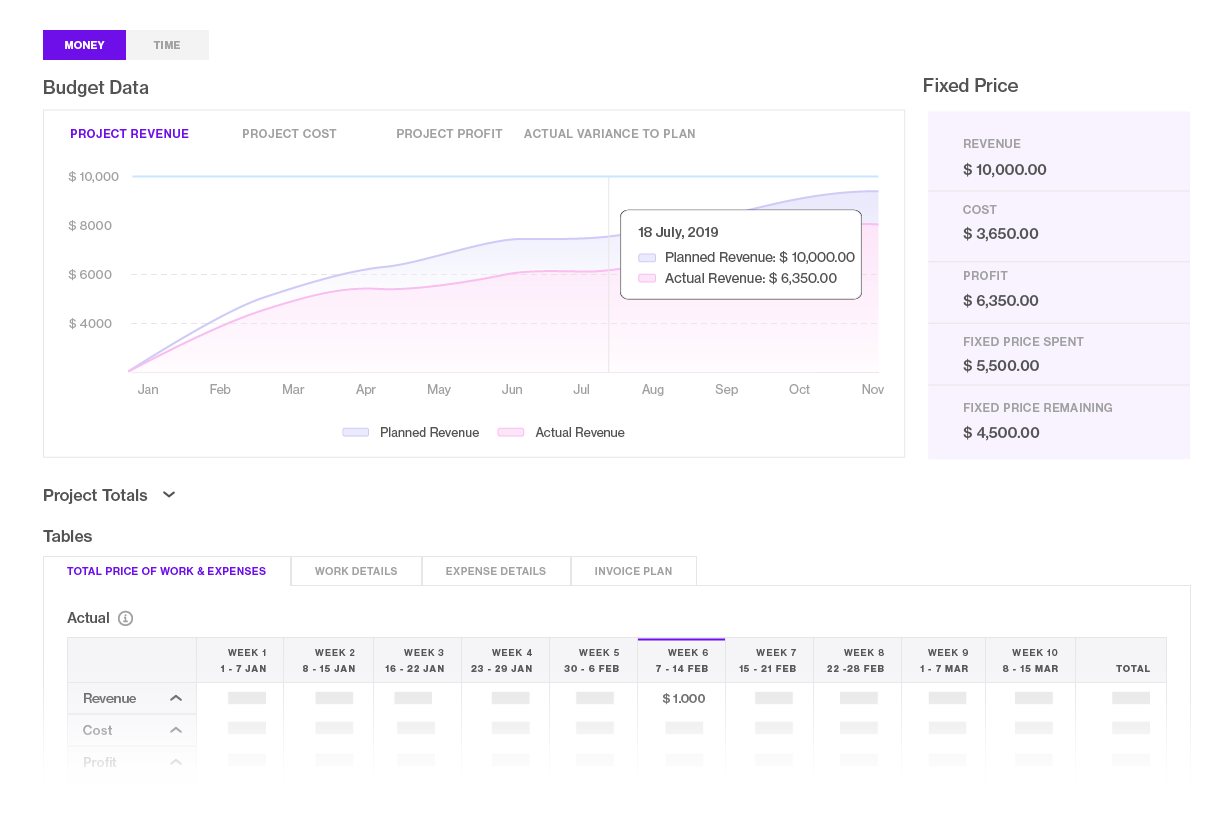
In case you're not interested in using Auto Schedule and prefer to estimate tasks and assign resources manually, Forecast will calculate the budget anyway, based on your estimates, rate cards, and internal hourly cost of your employees.
Learn from the experts: The best budgeting practices
Basics aside, it's time to learn from the experts. Project managers have lots of budget responsibilities, so we’ve talked to experienced project leaders and researchers. Below, they share their best practices and things to count in when creating a budget for a project.
Taoufik Samaka, Doctorate Researcher at Toulouse Business School:
Many budget slippages come from not taking the project risks seriously. Therefore, I would recommend a discussion with the risk manager to go through all eventual risks and potential opportunities, evaluate them by probability (likelihood to happen) and impact by value (if the risk happens, what would be the impact on the project in monetary value?). Also, evaluate the different strategies to handle the risk (accept, avoid, transfer, mitigate, exploit), define mitigation activities, reserve a contingency to handle your risks that are to be addressed. Project managers need to re-evaluate the risks on a regular basis and update the budget accordingly. A methodic risk management approach would help you cover risks related to all project process groups (most importantly: scope, schedule, cost, quality, resources, stakeholders).
Marco Donoso, IT Project Manager:
Besides using an appropriate estimation technique, like bottom-up, it is generally recommended to consider “contingency reserves” for known risks, and “management reserves” for unknown risks. So, for the first one, it is enough if you do good risk management by focusing only on risks that really matter and need a response plan. For the other one, it would be enough if you assign a % according to your company or business. For example, global companies usually put 5% for that.
Rogerio Manso, Senior Project Manager:
To budget a project it is critical that the project manager has clarity on three points.
- Project scope: It should be very clear about customer expectations to avoid any scope changes throughout the project.
- Resource availability: One of the biggest causes of budget failure is due to poor planning of resource availability. Holidays, illness, layoffs, resource replacements, working on multiple projects at the same time always have an impact on the budget.
- Risks: As already mentioned, it is important to pay close attention to risk management. No project is free of risks and impacts on budgets.
Finally, it is important to have good control of the project plan so that deviations are fixed quickly and not to have a major impact on the final budget.
Cassandra Mack, Senior IT Leader:
Take the time to find out who the "missing" stakeholders are. They are the ones that never hear about the project until later on and are indeed key to either getting something done or knowing where the bodies are buried that will cost you money, time, or some kind of resource tax later on in the project if you don't know about it upfront. You want to eliminate as many of those surprise eaters of contingency as possible. Don't be lazy with the risk management process. If you are lazy, you will end up eating your management reserves and will have to go back to the well to beg for money later on.
Don't be afraid to chunk the project into phases. You can't realistically budget for any known issues/risk farther out than the reasonably foreseeable future (depending on your line of work and forecast capabilities). If you are forced to do a multi-year budget, then add a confidence level for the pieces that are further out so you can quantify how much and what quality of data you have on hand. Chunk it up and you'll get better budget estimates and be able to adjust as you go with reasonable certainty.
Neil Woodger, Global Transformation Leader:
Ensure that you have very strong requirements and that they are fully agreed and signed-off. Scope creep is the biggest eater of the budget as a project moves forward.
Charles W. McBride, Project Leader:
Step away from the budget, sleep on it for a night, and take a hard look at each of those numbers again when you are fresh, asking a simple question: What did I/we miss?
We all miss something at one time or another, sometimes it’s big, sometimes it’s small. Strive to take the appropriate amount of time to always double-check all of your budgetary assumptions. Your reputation and your blood pressure will thank you later.
A checklist of things to create a project budget
There are many factors to take into account during a project budgeting process. Make sure you can answer the following questions:
- Can I define the project and its end goal?
- Are there any ground rules, constraints, and assumptions I should consider?
- Do I have sources of data (Task List, WBS, Cost Estimates, Schedule) to rely on?
- Is the estimating methodology in use acceptable?
- Do I know who is going to work on the project?
- Do I have a list of resources and their rates to complete the project?
- Can I compare my estimate against the best practices industry standard?
- Do I have contingency reserves to account for risk?
- Who are the key project team members to help me in estimating/budgeting process?
- Am I on the same page with Project Stakeholders?
- Can I compare the budget with original estimates and reconcile differences?
How intelligent automation can help
As you can see, the budget is an important part of planning and controlling your project. While you can manage to create project budgets manually, you’ll be more precise using project management software with budgeting features, especially if it’s a large project with tons of milestones and dependencies you’re running.
Project management systems like Forecast would calculate the budget for you based on the scoped out project. As soon as it’s approved by stakeholders and you have the Statement of Work defined, everything’s ready to start working. A scoped out project in Forecast is not just the recipe of your project full of tasks and milestones. It's also the scope that takes into account how long your previous projects have taken you and the roles you need to conduct the project.
The software learns from your previous projects and lets AI help you estimate each task and create a solid project schedule. All in one, the platform ensures you have a more precise project scope and a more precise budget in the end.
Forecast's premium plan will provide you with a visual budget that has a fast overview of revenue, cost, and profit and enables you to see how the time entries and invoices affect the budget and spot if you are on track or not.
Want to know more? Forecast is an AI-powered platform that helps project-based companies look into the future by connecting people and projects with insights and profitability. Continue reading how the platform can help you keep your projects on budget or book a demo on top of the page.
You might like to read these articles on our blog..
Subscribe to the Forecast Newsletter
Get a monthly roundup of productivity tips & hacks delivered straight to your inbox
